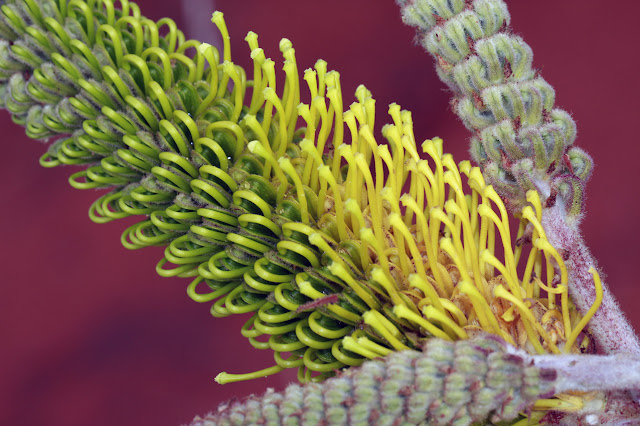This area is near the border of WA hidden on the edge of the ranges near Giles/Warakurna. Permits from the Aboriginal Lands Trust are required to travel through this region belonging to the Ngaanyatjarra people. There are a number of old, eroded, but colourful rocky ranges surrounding Giles/Warakurna, the Rawlinson Range to the west and the Schwerin Mural Crescent to the east. The little dot on the map denoting the Giles weather station hides a place of great beauty. I was blown away by the richness and ancientness of the land, and the luminous 'watercolour' light painting the landscape.
 |
| Giles Pinnacle in the Schwerin Mural Crescent |
Surrounding the hills are red sandplains covered in hard spinifex hummocks, their flower spikes waving gold, providing a bumper crop of seed for the zebra finches, budgies, spinifex pigeons and other wildlife. In the gullies grow the beautiful river red gums, further out are the smaller acacia (ironwood) and hakea (corkwood) trees while the Allocasuarina decaisneana (desert oak) thrives in the red dune country. The parallel dunes trace the direction of the prevailing winds, creating a drawing of subtle wind shifts around the hills when reading a map of the region.
 |
| Desert oak with red sand dune behind, north of Schwerin Mural Crescent |
At the base of the dunes grow these beautiful grevilleas, a haven for all sorts of honeyeaters, feeding and calling, flying from shrub to shrub. The flowers drip with sweet nectar.
The track to Gill Pinnacle is cryptic and very rough following a natural drainage line. These lovely pinky purple Ptilotus covered the ground on the way in.
 |
| Ptilotus |
Gill Pinnacle is a landmark hill very close to Gordon Springs at the base of the Schwerin Range.Iconic white trunked gums grow at the base of the hills. There was a small pool of water Gordon Springs with water seeping in from cracks in the rocks. Blanket ferns and rock ferns grow here along with mosses and liverworts. Native fig trees, and higher up, callitris trees cling to the rocky hillside. There were plenty of birds here. We saw the usual plenitude of honeyeaters plus black faced cuckoos shrikes feeding on insects on the trees in the gully and spinifex pigeons displaying on the higher rocky slopes. We even saw a lovely bower bird, but found no bowers even though we looked.
 |
| Looking towards Gill Pinnacle from Gordon Springs |
 |
| Looking toward Gordon Springs |
Growing among the white gums in the creekline were sandalwood trees, with blue grey foliage, recovering from obvious camel predation. Late in the afternoon we watched small woodswallows swooping and diving above the gully pool.
 |
| Seepage above Gordon Springs |
This image clearly shows the rocky nature of the ranges. Below the eroded peak is the clearly defined spinifex slope, below which grows gnarly acacia, hakea, callitris and other hardy shrubs. The photograph is taken from a drainage line which falls into Gordon Springs.
 |
| Looking up to Gill Pinnacle from the ledge above Gordon Springs |
In the evening and early mornings the ranges are transformed into another palette of colours. It is worth the effort to rise early and face the chilly morning air to experience it.
 |
| Schwerin Mural Crescent in the evening light |
 |
| Wispy sunrise at Gordon Springs looking south towards mulga (acacia) trees |










No comments:
Post a Comment